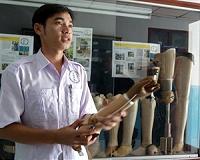| . |  |
. |
Vientiane (AFP) Nov 9, 2010 A conference that begins in Laos on Tuesday aims to speed up efforts to rid the world of cluster bombs, which are estimated to have killed or wounded tens of thousands of civilians. More than 1,000 government officials, charity workers and survivors of the bombs will gather for the first meeting of states that are party to the Convention on Cluster Munitions, which became international law on August 1. The four-day event "is expected to be a defining moment" for the convention, which is the most significant disarmament treaty in more than a decade, said the Cluster Munition Coalition, a non-governmental group working to eradicate weapons, which number in their millions. Cluster bombs, launched from the ground or dropped from the air, split open before impact to scatter multiple bomblets over a wide area. The bomblets can resemble a large flashlight battery or a tennis ball. Many fail to explode and can lie hidden for decades, posing a threat to unsuspecting farmers and children. "Cluster munitions cannot distinguish between soldiers and civilians, wartime or peace... children are at particular risk," said Stale Torstein Risa, the Norwegian ambassador to Vietnam and Laos, two of the most severely affected states. Norway was the first country to sign the convention, followed by Laos, the most heavily-bombed nation on earth per capita, according to the country's National Regulatory Authority (NRA), which coordinates work on unexploded ordnance (UXOs). In Vietnam, unexploded ordnance -- much of it cluster bombs -- has killed 10,529 people and wounded more than 12,000 in six heavily-contaminated central provinces, a study found last year. Iraq, Afghanistan and Lebanon also have have high numbers of confirmed casualties from leftover cluster munitions, said the Landmine and Cluster Munition Monitor, a non-governmental monitoring project. After Laos and Vietnam, Iraq and Cambodia have the largest areas of contaminated land. They are among at least 23 states and three other areas believed to have cluster bomb remnants, it said. The Cluster Munitions Convention entitles parties to financial and other assistance to clean up the explosives within 10 years. It prohibits all use, stockpiling, production and transfer of the weapons, and requires that victims be assisted. A total of 108 nations have signed the convention and more than 40 have ratified, which makes them full parties. The Landmine and Cluster Munition Monitor said 74 countries still have stockpiles of cluster bombs but about 20 have already destroyed or are eliminating them. Parties at the Vientiane conference are expected to adopt documents committing to rapid implementation of the convention's vision for a world free of the weapons.
Share This Article With Planet Earth
Related Links Our Polluted World and Cleaning It Up
 Mangled arms, legs legacy of cluster bombs in Laos
Mangled arms, legs legacy of cluster bombs in LaosVientiane (AFP) Nov 8, 2010 Novalee bounces up and down on his new artificial leg. "Comfortable. Comfortable," he says, smiling. A cluster bomb blew off his real limb below the knee, leaving Novalee, 38, among the estimated tens of thousands of civilians around the world who have been killed or wounded by the weapons. The Laotian Hmong man plans to tell his story at a conference that begins in the capital Vient ... read more |
|
| The content herein, unless otherwise known to be public domain, are Copyright 1995-2010 - SpaceDaily. AFP and UPI Wire Stories are copyright Agence France-Presse and United Press International. ESA Portal Reports are copyright European Space Agency. All NASA sourced material is public domain. Additional copyrights may apply in whole or part to other bona fide parties. Advertising does not imply endorsement,agreement or approval of any opinions, statements or information provided by SpaceDaily on any Web page published or hosted by SpaceDaily. Privacy Statement |